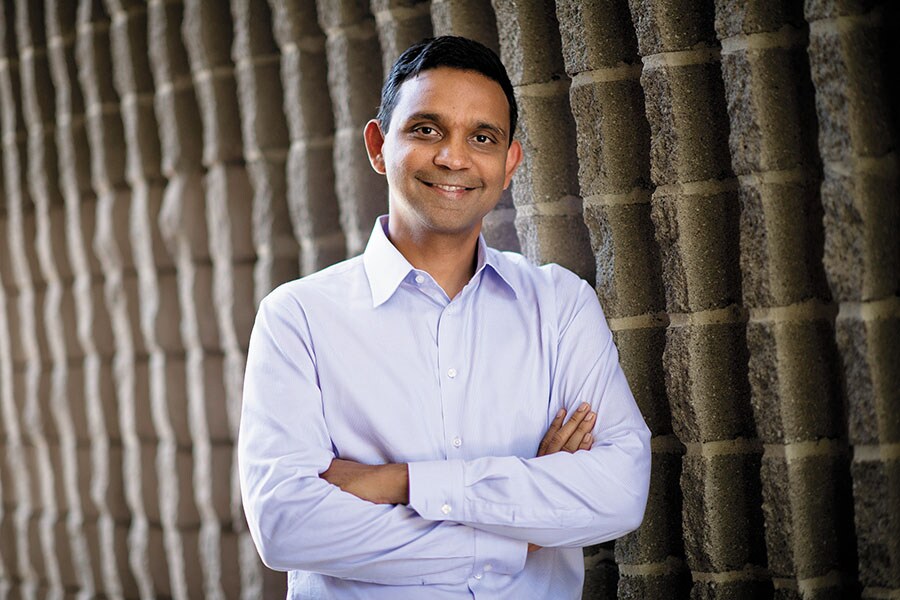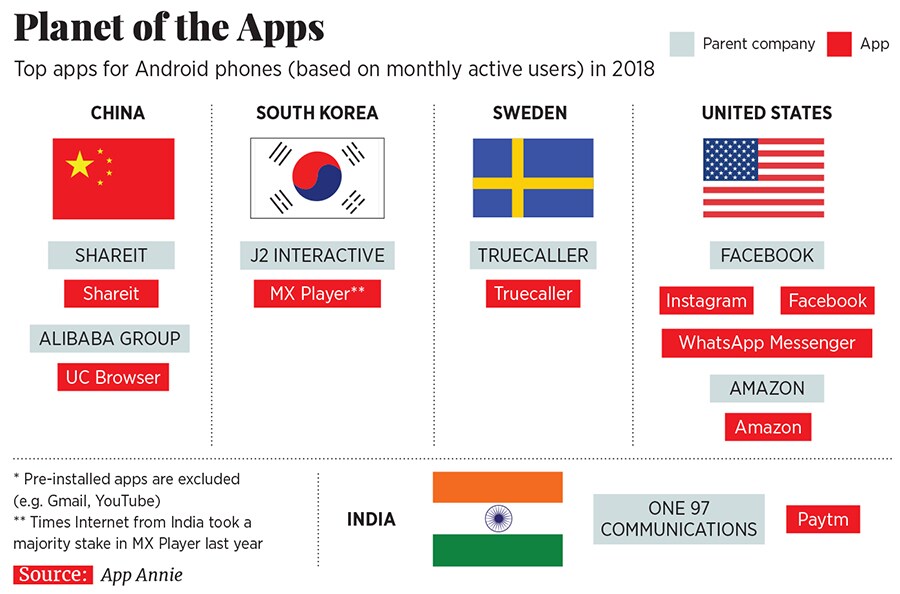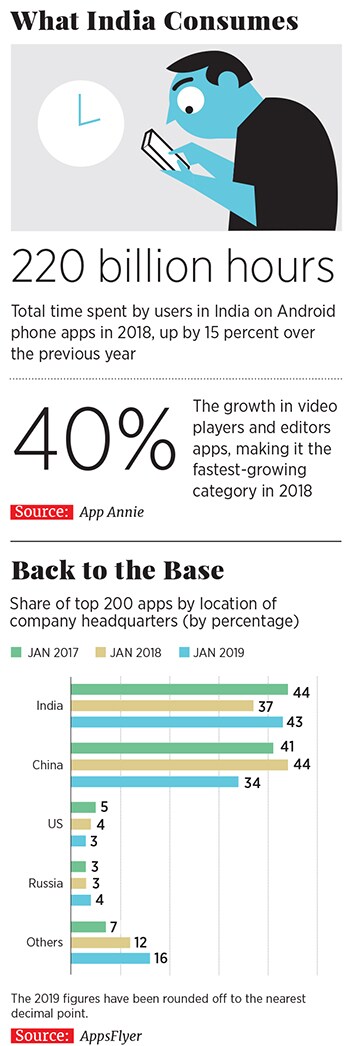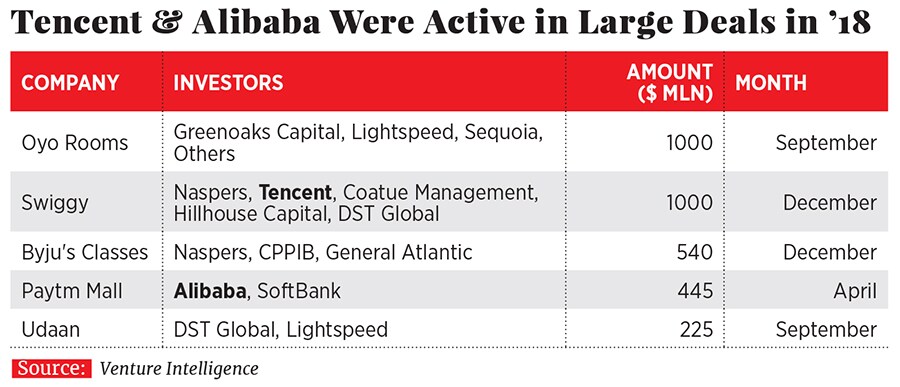Mobileground India: The Chinese invasion
The first wave of internet businesses may have belonged to America, but China's startups and investors are now leading the wave to dominate the mobile internet in developing markets. What does this me


 Illustration: Smaeer Pawar [br]Investor Venky Harinarayan is that rare raconteur whose storytelling flourish is led by what the data shows. In late 2017, the founding partner of venture capital firm Rocketship.VC, who lives in Saratoga, California, spotted something about India. His team had been monitoring apps that were growing quickly in India, a year after 4G data prices had dropped to record lows. “We just woke up and said, ‘What the heck is going on here?’,” Venky recalls.
Illustration: Smaeer Pawar [br]Investor Venky Harinarayan is that rare raconteur whose storytelling flourish is led by what the data shows. In late 2017, the founding partner of venture capital firm Rocketship.VC, who lives in Saratoga, California, spotted something about India. His team had been monitoring apps that were growing quickly in India, a year after 4G data prices had dropped to record lows. “We just woke up and said, ‘What the heck is going on here?’,” Venky recalls.
“We’d pick up the phone, make contact (with the app headquarters), and call these guys. Three or four in a row, we got companies from China.”
On January 12 last year, he wrote as much on online Q&A platform Quora, when asked about data-driven surprises. “Let me talk about the biggest surprise we have seen: The rise of the global Chinese start-up,” he wrote. “They are building products that are aimed at the world, not China. In particular, we were surprised to find Chinese app-makers focussed on the Indian market and having a huge success.”
The 2017-18 trend in India came up on another radar of American origin: AppsFlyer, a mobile marketing measurement tool to track users. Mobile app advertisers and developers in India use AppsFlyer’s software development kit to track the effectiveness of their ad-spends. Every year, AppsFlyer tracks the top 200 apps in India. “If you looked at the total number of installs happening in India, 60 percent were from China, America, and the UK,” says Sanjay Trisal, country manager of AppsFlyer India. “On AppsFlyer’s platform, nearly 50 percent of the apps tracked in India in 2017 were originating from China.” he adds.
Here is the exact share of the top 200 apps in India. In January 2017, China’s share was at 41 percent, just behind India (44 percent) but well ahead of the US (5 percent). A year later, it increased to 44 percent, with India dropping to 37 percent, and the US apps share too falling marginally. This January, the share of the apps originating from India recovered to 43.5 percent, with China’s share just under 35 percent.
Venky was on point. In a call from the US, he says: “The first run of the internet apps was won by web services from America—Google, Amazon, Facebook—which have morphed into the app era. But they are not as rampant in this next wave (mobile) as the Chinese apps are in the emerging markets.”
India has become a mobile battleground for the American and Chinese apps. “This is not an issue that surfaces in the US or the developed world,” Venky says. “This is unique to developing geographies. India is on top of the Chinese entrepreneurs’ list, No. 2 is Southeast Asia, and we are beginning to see Africa come in.” Venky Harinarayan, the founding partner of venture capital firm Rocketship.VC, says India is on top of the list for Chinese entrepreneurs
Venky Harinarayan, the founding partner of venture capital firm Rocketship.VC, says India is on top of the list for Chinese entrepreneurs
Image: David Paul Morris/ Bloomberg via Getty images[br]China Conundrum
In mid-April, Apple and Google removed TikTok, an app of Chinese origin, from their respective app stores, complying with an order passed by the Madurai bench of the Madras High Court on April 3. Mobile users download TikTok, owned by Chinese internet giant ByteDance, to create and share short videos. On April 24, the court lifted the ban.
Apps like TikTok, popular among youngsters, have gained notoriety for obscene and sexually-suggestive videos created and shared by users across languages and in non-urban areas. A former official of trade body Nasscom reckons this has implications on new segments of the society that are coming online. “The rapid expansion of their footprint has been a problem,” he says.
The ban on TikTok has stirred a debate because it will hold significance even for social media platforms Facebook and YouTube (a video platform owned by Google). “The order passed by the court has ramifications for other online services that scale up based on user-generated material or content,” says a technology lawyer. “Social media and vlogging (video blog) apps can be used for good and bad. To stop an entire app or platform is like shutting down Facebook or YouTube if they have objectionable content.”
Internet platforms or “intermediaries” operating in India have a “safe harbour protection” by law: Section 79 of the Information and Technology Act 2000, which says the platform itself cannot be liable for objectionable UGC. Section 79 had also introduced the concept of “notice and take down”—the responsibility on internet platforms to immediately remove objectionable content, once it is brought to their attention. For this, companies like Facebook have set up or outsourced content monitoring services in India.
In this context, the court ban on TikTok is a first in India. Ashish Aggarwal, Nasscom’s head of policy advocacy, says: “Fundamentally, the fact that an app has originated from a certain jurisdiction is not a reason to be concerned. The concern is around apps that are accessible to consumers, which do not comply with specific laws. The concern is: What kind of mechanism does India’s government have to ensure compliance?”
For now, the Americans and Chinese are at it in India.
Venture capital investors and entrepreneurs in India are hesitant or plain averse to speak openly about China, especially with the geo-political tension in February between India and Pakistan. The trigger for this was a terrorist attack in J&K’s Pulwama, in which 40 armed police personnel were killed. Pakistan-based militant group Jaish-e-Mohammed (JeM) had claimed responsibility.
In mid-March, China was the only permanent member of the United Nations Security Council, which did not designate JeM chief Masood Azhar as a global terrorist. In this context, China does make for an awkward subject in the Indian tech ecosystem, where more than 30 startups and fast-growing ventures have raised capital from investors based in the country, notably Tencent and the Alibaba Group.
“We do not have an option but to depend on global pools of capital,” says Karan Sharma, executive director and co-head of Avendus Capital’s digital and technology investment banking. “The US and Chinese investors are critical for our digital economy to grow. And it is a mutual relationship. Yes, there will be questions raised, and there may always be some friction. But they cannot ignore our market, and we cannot ignore them as a source of capital. It is a commercial win-win proposition.” Sharma agrees that geo-political issues like national security and policy, content and news-related agenda, telecom hardware and equipment are hard to ignore.
This played out in the financial technologies space in 2018. Almost 47 percent of One 97 Communications (which runs digital wallet Paytm) was owned by Alipay Singapore and Alibaba.com Singapore until March 31, 2017. Alibaba is headquartered in China, and has aggressive ambitions as a strategic investor. By March 31, 2018, the Alipay and Alibaba combined shareholding had come down to under 40 percent. Alipay Singapore had reportedly raised funds by issuing equity shares through private placement cum preferential basis and under ESOP scheme. “There is a change in the percentage of shareholder’s earnings, though there is no actual change in the number of shares held by the shareholder,” stated One 97 Communications in its Registrar of Companies filings.
Government and regulators are particularly watchful about the possibility of cross-border flow of data. For instance, the Draft e-Commerce Policy, brought out by the Department of Promotion of Industry and Internal Trade, calls for broad restrictions. In its comments dated March 29, trade body Nasscom called such an approach “worrisome as the policy erroneously equates restriction on cross border flow of data with access to data”.
There are deeper implications for flow of personal data in sectors like healthtech and financial services, which the RBI flagged off in April 2018. It had called for measures to ensure that financial services operators maintain all payment systems data to be stored inside India. “Ensuring the safety and security of payment systems data by adoption of the best global standards, and their continuous monitoring and surveillance is essential to reduce the risks from data breaches...,” it stated.
Data Dictum
Among the American multinationals, the feeling is that the regulators’ thrust to keep and process data within India smacks of how China has ring-fenced its internet economy. It could also impact innovation, which happens globally based on real-time user data. “Data localisation is for jurisdiction control,” says a source in Delhi, who engages with policymakers and technology companies. In case of any untoward event or breach, the government wants to be sure it has the ability to manage the situation within the country. “What does the government do if they want to investigate a case, and do something?” asks another source of a lobby group.
However, while ‘physical location of data’ may have a legal justification, it has no meaning in the technology parlance, says the source in Delhi. “The tools that you use to develop, run, operate and distribute on the internet can come from anywhere in the world. So the rationale behind localisation has limited meaning,” he explains.
“Sure Alibaba is a Chinese-origin company. But is it a Chinese company governed by China? The answer is no, considering it is listed on the New York Stock Exchange. But will China have an influence over Alibaba? The answer is yes, just as much as the US government can have influence over Google and Amazon.”
India wants that order of influence, which many agree will come with the Personal Data Protection (PDP) bill. In 2017, the Ministry of Electronics and Information Technology and Niti Aayog began to act fast in pushing for progressive policies. But, according to all the three sources, the activity came to a halt with the election in five states last year. The PDP bill will now come up before Parliament only after the new government is elected.
“There has been no consistent view of this in the government, and it is not going to emerge until elections are over,” says another member of a business lobby. The Niti Aayog has come to be seen as open, whereas the Ministry of Commerce and Industry is perceived to be nationalistic.
“The real thing is not about data. This is not an easy problem to solve. The colony at the app level is not a problem anymore. The problem is in the deeper infrastructure. We are already like Europe today,” says the member of the business lobby.
Colour of Money
Meanwhile, for tech startup entrepreneurs in India, it is about having the right investor on the cap table. “We are in an environment, where local capital is constrained,” says a venture capitalist in Mumbai. In this respect, the Chinese come with an innately better understanding of India as a developing market, than their American counterparts.
The exception in India may be WhatsApp, a product built in the US. People in India have got more used to Google and Facebook, which have been here for at least 15 years. But if Chinese apps find it tougher to cope with India’s early internet adopters, they have a shot at the new markets that 4G is opening up.
The VC investor says Chinese companies have created platforms to retain revenue and profits. Now the likes of Tencent and Alibaba are expanding such ecosystems across countries, as investors. “The likes of Google and Facebook have not been as active as investors in deploying their profits to fund Indian ventures,” he says. “If a homegrown tech startup has to attract users, they spend (digital advertising) money on Facebook and Google,” he adds. In effect, China is participating more in India’s startups market, even as the American giants profit from India’s tech ecosystem.
“Chinese investors expect to see very high growth and scale,” says Sharma of Avendus. They want to dominate categories and monetise, but make exceptions in certain categories like content and news apps. They are fine with content companies, where growth in MAU (monthly active users) or DAU (daily active users) and engagement is massive, and user growth is super-aggressive, but monetisation is yet to evolve. “In contrast, monetisation is critical for Western investors. It’s very difficult for an American investor to look at content companies without any monetisation and strong unit economics,” Sharma says. But when the Chinese are evaluating ecommerce businesses, the growth metrics consideration set is similar to that of the Americans.
So far, Tencent has operated as a financial investor with strategic intent: Back companies that align with their overall strategy. “They seem to be fairly flexible in their approach and can back ventures at an early stage also, or at a later stage where a company is looking to raise a $100 million+ round,” Sharma says. Its exposure across category leaders like Ola, Swiggy, Practo, Byju’s and Gaana are typically sub-25 percent stake.
However, Alibaba and its affiliate Ant Financial Services Group’s approach in India has been more as a strategic investor. “Its ownership thesis is for a large shareholding, with the ability to influence strategic decisions and roadmap,” Sharma explains, citing its high exposure in Paytm, Paytm Mall, Xpressbees, and Zomato.
Market Play
SHAREit and UC Browser are two apps that have originated in China, and among the top 10 apps in India since 2016, according to App Annie. SHAREit, a popular app built to transfer video, music, and files from one device to another, is at No. 3 and UC Browser at 7. In comparison, five apps from the US dominate the charts, which exclude Gmail and YouTube because they are preinstalled in Android phones. The metric used in the top-10 chart was monthly active users (MAU) on Android phones, where apps of US-headquartered companies are winning.
But in an App Annie list of the top 30 apps in India by consumer spend (iOS and Google Play combined), the apps originating from China improved their share from 3 percent in 2016 to 17 percent last year. In the same period, the apps that originated from the US saw their share drop from 43 percent to 33 percent. So, the American apps are beginning to feel the heat.
But it’s the content and short-video apps from China that have caught the eye in India, both for good and bad reasons. “Recent models like short mobile videos have emerged in China, and not in the US, which gives the Chinese an advantage in porting those apps over to India,” says Harinarayan of Rocketship.vc. “In the mobile space, you will see a lot of Chinese companies with interesting business models. The new paradigms are being created in China.”
It was a surprise in 2017, says Umang Bedi, president of DailyHunt, a multilingual content discovery app that has been built from Bangalore. “It wasn’t on anyone’s radar in Facebook in India or globally that there are Chinese apps coming in here,” says Bedi, then managing director of Facebook India and Southeast Asia. “Before 2017, there was no TikTok. Musical.ly was a separate teenage-based app. There was no Helo. NewsDog was there.”Virendra Gupta, founder of DailyHunt, says the question is how many of the Chinese apps will exist one year hence. “There is momentum money that comes that helps to get an app store ranking, but the biggest thing is to continuously provide value to the user,” he says. “Retaining attention has been harder.”
Adds Bedi: “All the handset partners have discontinued their partnerships with some of these apps because mobile users have objected. There is a issue for them in understanding India, our publisher landscape, building AI and machine learning models that can cater to local language, and a personalised user experience without paying the user.”
DailyHunt claims that 60-70 percent of its app installations happen beyond Google Play Store. “Our app is pre-burnt in all the mobile handsets,” says Gupta, as Bedi counts out 10 smartphone brands that DailyHunt has partnered with.
But here’s the thing: ByteDance’s TikTok was an overseas play of the Chinese app Douyin for creating and sharing short videos, and has been in existence since late 2017. By then, ByteDance already had a small stake in DailyHunt (in 2016) for a taste of India. The Chinese have been around. As an investor says, “Everything the Chinese do has only one narrative: Dominate.”
First Published: Apr 30, 2019, 08:43
Subscribe Now
